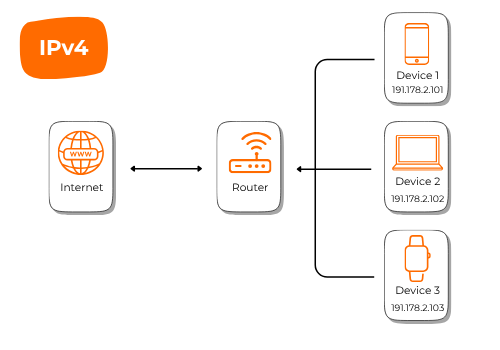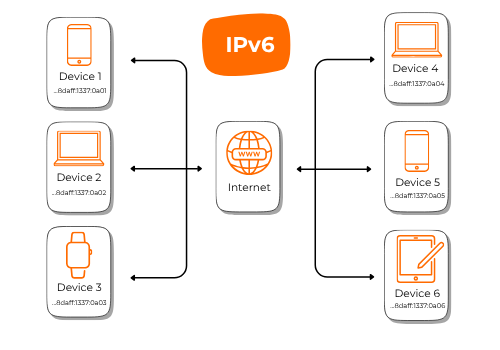What is an IP address and what function does it serve?
Every device connected to a network or the Internet needs a unique identifier. This identifier is known as an IP address. Without it, data exchange between servers and clients or between different locations or services would not be possible.
An IP address works in a similar way to a postal address. It ensures that information arrives at the correct destination device. An IP address can be either static (permanently assigned) or dynamic (reassigned with each connection). Fixed IP addresses are often used in business environments because they can be integrated more reliably into firewalls, VPNs, and network configurations. There are two main standards: IPv4 and IPv6.
IPv4 – The classic among network protocols
IPv4 stands for “Internet Protocol Version 4” and was developed back in 1981. It is based on 32 bits, which theoretically allows for around 4.3 billion unique addresses. However, given the global increase in Internet-enabled devices, this address space quickly became scarce.
A typical IPv4 format looks like this:
192.168.1.1
IPv4 is still in use in most networks today and will continue to be supported. IPv4 remains relevant, particularly for smaller corporate networks, classic DSL connections, or internal company infrastructures, due to its long-standing establishment.
However, the increasing scarcity of address resources is a disadvantage. Although NAT (Network Address Translation) allows multiple devices to be operated behind a public IP address, this leads to technical limitations and complexity. This can be particularly challenging for cross-location communication or modern cloud applications.

IPv6 – The modern successor with extended functionality
IPv6 was developed as the successor standard to IPv4 and is based on 128 bits. This provides a total of around 340 sextillion IP addresses. A sextillion is a number with 36 zeros. That's enough to assign a unique address to every device in the world.
An IPv6 format looks like this:
2001:0db8:85a3:0000:0000:8a2e:0370:7334
Advantages of IPv6 at a glance:
Significantly larger address space
More efficient forwarding of data packets (routing)
No need for NAT
Simplified network configuration (e.g., through SLAAC – Stateless Address Autoconfiguration)
Integrated security features such as IPsec
IPv6 is the future-proof choice, especially in growing corporate networks, IoT applications, and connections to modern cloud infrastructures. Large providers, data centers, and international companies are already relying on IPv6 as the standard.

Overview of differences between IPv4 and IPv6
| Merkmal | IPv4 | IPv6 |
|---|---|---|
| adress length | 32 Bit | 128 Bit |
| adress space | ca. 4,3 billion | ca. 340 sextillion |
| natation | Ddecimal, e. g. 192.168.0.1 | hexadecimal, e. g. 2001:0db8::1 |
| NAT required | jes | no |
| autoconfiguration | restricted | supported (SLAAC) |
| security | optional (e. g. IPsec) | integrated |
What is the IP protection class?
The term IP address is often confused with the so-called IP protection class. These are two completely different concepts.
The IP protection class, officially referred to as “International Protection” or “Ingress Protection,” defines the degree of protection of a technical device against foreign objects and moisture. It has nothing to do with network addressing. Typical IP protection classes in the IT environment are, for example, IP20 (protection against contact with fingers) or IP54 (protection against dust and splashing water).
In contrast to the IP address, which identifies network connections, the IP protection class refers to the physical resistance of a product. However, this can still play a role for network components such as routers or switches, for example in outdoor applications or in industrial environments with high levels of dust or moisture.
When is it worth switching to IPv6 in a corporate network?
Although IPv6 offers many advantages, the switch is not absolutely necessary in all cases. Smaller companies with a manageable network infrastructure can continue to work with IPv4. This is especially true since many systems are still designed for IPv4 and the switchover incurs costs.
Nevertheless, it is advisable to purchase new devices and applications that are already IPv6-compatible. IPv6 should be taken into account, particularly when planning new network structures or setting up cloud and remote access solutions. Hybrid scenarios with dual stack, i.e., the parallel operation of IPv4 and IPv6, are also common transitional solutions.
Challenges in the introduction and use of IPv6
Despite the technical advantages, the path to widespread use of IPv6 is fraught with various hurdles. Many companies are still hesitant to make the complete switch. There are many reasons for this:
Compatibility with existing infrastructure: Many older devices and applications are not IPv6-compatible
Training requirements: IT teams need to familiarize themselves with new protocol mechanisms and configurations
Complexity of troubleshooting: Analyzing IPv6 addresses is more time-consuming
Administrative effort in mixed operation (dual stack): Operating IPv4 and IPv6 in parallel requires additional effort
Security aspects: New features mean new potential attack vectors if they are not implemented correctly
These factors make it clear that a structured migration plan is necessary to avoid risks and use resources efficiently.
Outlook – What's next for IPv6?
Even though IPv4 is not going away anytime soon, the long-term outlook is clearly in favor of IPv6. The continuously growing number of networked devices, increasing data traffic, and the trend toward cloud solutions require scalable and stable network architectures.
More and more Internet service providers and hosting providers are switching completely to IPv6.
Mobile phone providers work almost exclusively with IPv6.
In the Internet of Things (IoT) sector, there is no alternative to IPv6.
IPv4 addresses are becoming increasingly expensive and difficult to obtain.
Companies that switch to IPv6 early on secure competitive advantages through better performance, simpler networks, and future-proofing.
Conclusion – IPv6 is more than a technical upgrade
The decision between IPv4 and IPv6 depends on your requirements, existing infrastructure, and future growth plans. IPv4 will remain relevant for the foreseeable future – however, IPv6 is increasingly becoming the standard for modern network architectures.
Anyone planning new network components or wanting to expand existing structures should pay attention to IPv6 compatibility. Careful planning and modern hardware ensure flexibility and future-proofing.
Network consulting and suitable hardware at IT-Market.com
At IT-Market.com, you will find a wide selection of IPv4- and IPv6-compatible routers, switches, and security components – as new or refurbished devices with up to a 3-year warranty for businesses. Our team of certified technical experts will be happy to assist you in planning, expanding, or modernizing your network infrastructure – tailored to your individual requirements.
Do you have questions about the IPv6 transition, need compatible hardware, or would you like a no-obligation consultation? Then our team will be happy to assist you – by phone, email, or via our online form. Together, we will find the right solution for your network.
